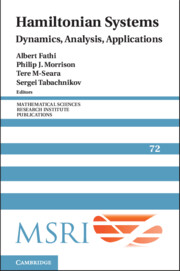Book contents
- Frontmatter
- Contents
- Denjoy subsystems and horseshoes
- Impact Hamiltonian systems and polygonal billiards
- Some remarks on the classical KAM theorem, following Pöschel
- Some recent developments in Arnold diffusion
- Viscosity solutions of the Hamilton–Jacobi equation on a noncompact manifold
- Holonomy and vortex structures in quantum hydrodynamics
- Surfaces of locally minimal flux
- A symplectic approach to Arnold diffusion problems
- Hamiltonian ODE, homogenization, and symplectic topology
Impact Hamiltonian systems and polygonal billiards
Published online by Cambridge University Press: 10 May 2024
- Frontmatter
- Contents
- Denjoy subsystems and horseshoes
- Impact Hamiltonian systems and polygonal billiards
- Some remarks on the classical KAM theorem, following Pöschel
- Some recent developments in Arnold diffusion
- Viscosity solutions of the Hamilton–Jacobi equation on a noncompact manifold
- Holonomy and vortex structures in quantum hydrodynamics
- Surfaces of locally minimal flux
- A symplectic approach to Arnold diffusion problems
- Hamiltonian ODE, homogenization, and symplectic topology
Summary
The dynamics of a beam held on a horizontal frame by springs and bouncing off a step is described by a separable two degrees of freedom Hamiltonian system with impacts that respect, point wise, the separability symmetry. The energy in each degree of freedom is preserved, and the motion along each level set is conjugated, via action angle coordinates, to a geodesic flow on a flat two-dimensional surface in the four dimensional phase space. Yet, for a range of energies, these surfaces are not the simple Liouville–Arnold
tori—these are compact orientable surfaces of genus two, thus the motion on them is not conjugated to simple rotations. Namely, even though energy is not transferred between the two degrees of freedom, the impact system
is quasiintegrable and is not of the Liouville–Arnold type. In fact, for each level set in this range, the motion is conjugated to the well studied and highly
nontrivial dynamics of directional motion in L-shaped billiards, where the billiard area and shape as well as the direction of motion vary continuously on isoenergetic level sets. Return maps to Poincaré section of the flow are
shown to be conjugated, on each level set, to interval exchange maps which are computed, up to quadratures, in the general nonlinear case and explicitly for the case of two linear oscillators bouncing off a step. It is established that for any such oscillator-step system there exist step locations for which some of the level sets exhibit motion which is neither periodic nor ergodic.
Changing the impact surface by introducing additional steps, staircases, strips and blocks from which the particle is reflected, leads to isoenergy surfaces that
are foliated by families of genus k level set surfaces, where the number and order of families of genus k depend on the energy.
by segments belonging to confocal quadrics [7; 8; 13]. The resulting dynamics are related to deep mathematical theories on interval exchange maps (IEM), on directed motion on translation surfaces, on genericity of curves in the space of affine lattices, on the Teichmüller geometry of moduli space and even on some results in number theory; see [5; 13; 26]. We show that this fascinating collection of interrelated mathematical fields are also related to the rich research area of Hamiltonian impact systems (HIS). Thus, these theories are related to a large variety of physically realizable models. We present this connection in the simplest possible setting and in the discussion we comment on some future synergetic directions.
Information
- Type
- Chapter
- Information
- Hamiltonian SystemsDynamics, Analysis, Applications, pp. 29 - 66Publisher: Cambridge University PressPrint publication year: 2024
